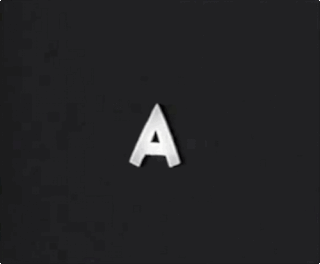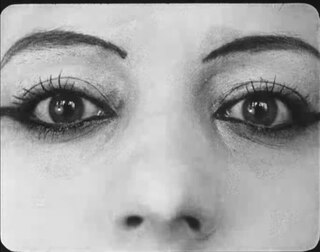Related Research Articles

Eaux d'artifice (1953) is a short experimental film by Kenneth Anger.

The Fall of the House of Usher (1928) is a short silent horror film adaptation of the 1839 short story "The Fall of the House of Usher" by Edgar Allan Poe. The movie was co-directed by James Sibley Watson and Melville Webber, and starred Herbert Stern, Hildegarde Watson, and Melville Webber. It tells the story of a brother and sister who live under a family curse. An avant-garde experimental film running only 13 minutes, the visual element predominates, including shots through prisms to create optical distortion. There is no dialogue in the film, though one sequence features letters written in the air moving across the screen.

Manhatta (1921) is a short documentary film directed by painter Charles Sheeler and photographer Paul Strand.

A Movie is a 1958 experimental collage film by American artist Bruce Conner. It combines pieces of found footage taken from various sources such as newsreels, soft-core pornography, and B movies, all set to a score featuring Ottorino Respighi's Pines of Rome.

The Dickson Experimental Sound Film is a film made by William Dickson in late 1894 or early 1895. It is the first known film with live-recorded sound and appears to be the first motion picture made for the Kinetophone, the proto-sound-film system developed by Dickson and Thomas Edison. The film was produced at the "Black Maria", Edison's New Jersey film studio. There is no evidence that it was ever exhibited in its original format.

Experimental film or avant-garde cinema is a mode of filmmaking that rigorously re-evaluates cinematic conventions and explores non-narrative forms or alternatives to traditional narratives or methods of working. Many experimental films, particularly early ones, relate to arts in other disciplines: painting, dance, literature and poetry, or arise from research and development of new technical resources.

A Bronx Morning is a 1931 American Pre-Code avant-garde film by American filmmaker Jay Leyda (1910–1988).
Nostalgia, styled (nostalgia), is a 1971 American experimental film by artist Hollis Frampton. It is part of his Hapax Legomena series.
Structural film was an avant-garde experimental film movement prominent in the United States in the 1960s. A related movement developed in the United Kingdom in the 1970s.
OffOn is an experimental film created by Scott Bartlett made and released in 1968.
Sidney Peterson, was an American writer, artist, avant-garde filmmaker, and educator. He founded the first film courses at the California School of Fine Arts in 1947.
Castro Street (1966) is a visual nonstory documentary film directed by Bruce Baillie.

The National Film Registry (NFR) is the United States National Film Preservation Board's (NFPB) collection of films selected for preservation, each selected for its historical, cultural and aesthetic contributions since the NFPB's inception in 1988.
Glimpse of the Garden is a 1957 five-minute short experimental film made by Marie Menken, showing film clips of a garden, with birds chirping for the soundtrack. In 1958, the film won an award at the Exposition Universelle et Internationale at Brussels. In 2007, the film was included in the annual selection of 25 motion pictures added to the National Film Registry of the Library of Congress being deemed "culturally, historically, or aesthetically significant" and recommended for preservation.
Free Radicals is a black-and-white animated film short by avant-garde filmmaker Len Lye. Begun in 1958 and completed in 1979, Lye made the film by directly scratching the film stock. The resulting "figures of motion" are set to music by the Baguirmi tribe of Africa.
Early Abstractions is a collection of seven short animated films created by Harry Everett Smith between 1939 and 1956. Each film is between two and six minutes long, and is named according to the chronological order in which it was made. The collection includes Numbers 1–5, 7, and 10, while the missing Numbers 8 and 9 are presumed to have been lost.
The Red Book is a 1994 American experimental animated short film by experimental filmmaker and theater/installation artist Janie Geiser.
Study of a River is a 1997 experimental film directed by Peter Hutton.
Tarantella is a five-minute color, avant-garde animated short film created by Mary Ellen Bute, a pioneer of visual music and electronic art in experimental cinema.
Fake Fruit Factory is a 1986 American experimental documentary film by Chick Strand.
References
- ↑ Sidney Peterson, 94, Surrealist Filmmaker-The New York Times
- ↑ Letterboxd
- ↑ "Complete National Film Registry Listing". Library of Congress. Retrieved 2020-05-04.
- ↑ "Michael Jackson, the Muppets and Early Cinema Tapped for Preservation in 2009 Library of Congress National Film Registry". Library of Congress. Retrieved 2020-05-04.
- ↑ "Avant-Garde Volume 3 - Kino on Video". Archived from the original on 2010-12-02. Retrieved 2010-12-05.